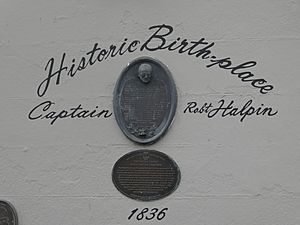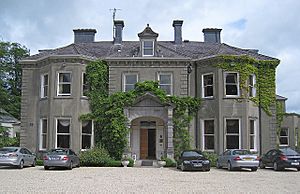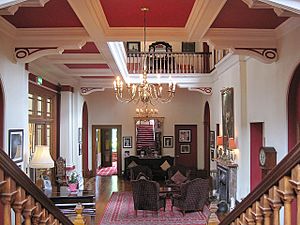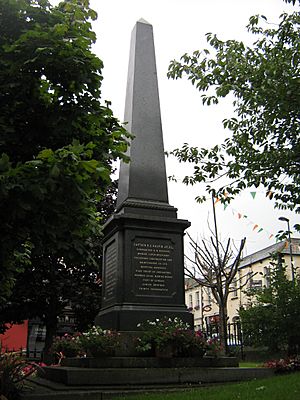Robert Halpin facts for kids
Quick facts for kids
Robert Halpin
|
|
|---|---|
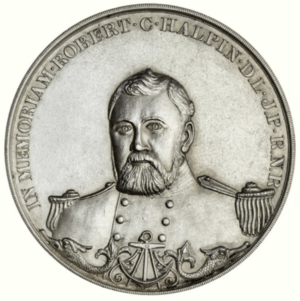
Depiction on the Halpin Memorial Medal
|
|
| Born | 16 February 1836 Wicklow, Ireland
|
| Died | 20 January 1894 (aged 57) Tinakilly, County Wicklow, Ireland
|
| Nationality | Irish |
| Other names | Mr. Cable |
| Occupation | sailor |
| Years active | 1846–1870s |
| Known for | Laying transoceanic telegraph cables |
Robert Charles Halpin was an amazing Irish sailor, born on February 16, 1836, in Wicklow. He became famous for captaining the huge steamship SS Great Eastern. This ship was special because it laid telegraph cables across the ocean floor. Because of his success, people called him "Mr. Cable"! He passed away on January 20, 1894, at his home in Tinakilly, Wicklow.
Contents
Early Life: A Boy and the Sea
Robert was the youngest of 13 children. His dad owned a small pub, and his family was quite comfortable. From a very young age, Robert loved the sea. He went to a private school nearby, but he wasn't very interested in school. Instead, he loved listening to sailors tell stories about far-off places in his father's pub. When he was just ten years old, he left home to become a sailor!
Robert's Sailing Adventures
Robert's life at sea started with a bang! He joined a ship called the Briton, which carried coal. In 1851, his ship was wrecked off the coast of Cornwall, England. Many people lost their lives, but Robert bravely made it to shore.
Later that year, he joined the Henry Tanner, a ship that sailed between Britain and Australia. His first trip to Australia happened during the exciting Australian Gold Rush of 1852. More than half the crew left the ship to search for gold! The Henry Tanner had to stay in port until the crew came back.
After that, Robert became a third mate on the ship Boomerang. This ship sailed from Liverpool to Melbourne, Australia, and then to Ecuador. It returned with a cargo of guano, which is bird droppings used as fertiliser (plant food).
Robert then became second mate on the Salem, a ship that carried wool. He soon realized that steamships were the future of travel. So, he switched from sailing ships to steamships and became the first officer on the Khersonese.
When he was only 22, Robert became the captain of the S.S. Propellor. He later joined another steamship called Circassian. In 1858, he started working on a new, faster route across the Atlantic Ocean from Galway, Ireland, to Newfoundland. Many people were moving from Europe to North America, and this was a big shipping business. By 1859, Robert was captain of the popular S.S. Argo. But disaster struck in August 1859 when the Argo hit an iceberg in thick fog and sank. Robert lost his captain's license after this accident.
Even with this setback, the Spanish Government hired him in 1860 to deliver two troop ships to South America. During the American Civil War, Robert helped bring supplies to the Southern states and carried cotton back to Europe, avoiding the Northern forces. In 1864, he had to crash his ship on purpose to avoid being caught. He was held by the Northern forces but was later released.
It was after these adventures that Robert Halpin began his amazing work with the steamship Great Eastern.
The Incredible Great Eastern
The Great Eastern was a truly massive ship, designed by a famous engineer named Isambard Kingdom Brunel. It was launched in 1858 and was an incredible 693 feet (200 m) long – that's over 200 meters! It weighed 22,500 tons and could carry more than 3,000 passengers. It was five times bigger than any other ship built at that time! It had six masts, five funnels, and huge paddle wheels. It even had the biggest propeller ever built!
The Great Eastern had a bit of bad luck in its early days. It was meant for long trips, like from Britain to Australia, but it ended up being used on shorter Atlantic routes, which wasn't very profitable. It was sold many times. In 1867, it was hired to bring American visitors to a big exhibition in Paris. Only 191 passengers came, including the famous writer Jules Verne, who later wrote a book about the ship called A Floating City.
Connecting the World with Telegraph Cables
Before the 1860s, people were very interested in Telegraphy, which is a way to send messages using electrical signals. They wanted to connect Europe and North America with a telegraph cable under the ocean. The first successful cable was laid in August 1858. Queen Victoria of the United Kingdom even sent a message to the American President James Buchanan using it! This first cable proved it could be done, but it broke after only a week because someone used too much electricity.
A man named Cyrus Field was a pioneer in this field. Cables had already connected parts of Europe, and also Europe to Britain, and Britain to Ireland. A company was formed that changed the Great Eastern into a cable-laying ship. Robert Halpin was made the First Engineer. Their big job was to lay a transatlantic telegraph cable from Valentia Island in Ireland to Heart's Content in Newfoundland. This cable was 2,600 miles (4,200 km) long and weighed 6,000 tons!
When they were 1,862 miles (3,000 km) from Ireland, the cable broke, and the Great Eastern had to go back to Europe. But in 1866, with Robert Halpin now in charge, the ship returned to the exact spot, found the broken cable, and fixed it! In July of that year, the Great Eastern arrived in Newfoundland, completing the connection between the continents. This connection has worked ever since!
Later, as captain, Robert Halpin laid an amazing 26,000 miles (41,800 km) of cable – that's more than enough to go around the world! These cables connected places like France to St. Pierre and Miquelon, Bombay to Aden and Suez, and Australia to New Zealand and the East Indies.
For his great work, Robert Halpin received many honors. The Emperor of Brazil made him a Knight of the Order of the Rose. He also received the Legion d'honneur from France and became a Fellow of the Royal Geographical Society. He knew many important people, including Lord Kelvin, who helped with the cable laying, and the famous writer Alfred Lord Tennyson.
Later Life and Legacy
Around 1875, Robert Halpin returned to his hometown of Wicklow, Ireland. He became the head of the Wicklow Gas Company and the Wicklow Harbour Master. He also helped build the East Breakwater, a very important structure for the port.
Robert was married to Jessica Munn from Newfoundland, and they had three daughters: Ethel, Belle, and Edith.
Tinakilly House: Robert's Home
The British Government rewarded Robert Halpin for his huge contribution to improving world communication and trade. In 1876, he bought land near Wicklow Town and built a beautiful house called Tinakilly.
He hired a famous architect to design the house, which cost a lot of money – about £40,000 at the time! It had many fancy features and was surrounded by 400 acres of land, including a large rose garden. Today, Tinakilly House is a hotel, and it still has many of its original features.
Robert Halpin passed away at Tinakilly on January 20, 1894, at the age of 57. He is buried in the Wicklow Parish Church, with a Celtic Cross marking his grave.
Remembering Robert Halpin
Many items from Robert Halpin's life were given to the Maritime Institute of Ireland by his daughters. You can see a display about him at the National Maritime Museum of Ireland in Dún Laoghaire.
The Wicklow Obelisk
In 1897, a tall stone monument called an obelisk was put up in the center of Wicklow town to remember Robert Halpin's life and achievements. The land for the obelisk was given by a local Earl, and the area is now called Fitzwilliam Square.
The Halpin Memorial Medal
After the money was collected for the Wicklow obelisk, there was some extra money left over. This money was used to create the Halpin Memorial Medal. This was an annual prize given to the best boy and girl swimmers at the Merchant Seamen's Orphan Asylum (which later became Bearwood College). This award continued for about seventy years, until the 1960s.
The medal was made of silver and had Robert Halpin's image on one side. The other side changed over time but always included the name of the school.
See also
- List of people on stamps of Ireland


